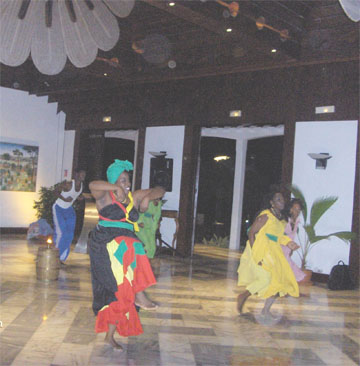Guadeloupe is an interesting and at times peculiar place where you can get lost if you somehow stumble off track while navigating the island. It is actually an archipelago so you could end up on any one of the five islands in the territory.
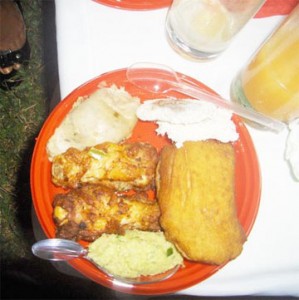
It is more French than Caribbean though residents shy away from making a distinction; they prefer the best of both worlds. However, there are those who openly say it is a French territory and that they pray it remains that way.
The idea of independence seems to scare Guadeloupians. They rarely speak about it and when they do, it is always in hushed tones and with facial expressions that reveal their inner feelings about having the status quo remain. But even with the desire to remain a French Overseas Department, there still burns a fire in some on the island to be recognized as Caribbean.
“I was born French and Caribbean, but if you look at me what do you see?” a man asked when casually asked about his roots, alluding to his ethnicity as if it provided answers. But he quickly laughed and said, “We were blessed two times,” referring to the island’s francophone Caribbean custom.
Guadeloupe has a quiet beauty; a stunning landscape of sprawling blue water and thick foliage, mostly banana plantations. Its intricate though easy to navigate roadways, large apartment duplexes and sea of European-made cars offer a modern French feel, but as you journey across the island, some things feel common; like the street art (graffiti), that covers a string of buildings.
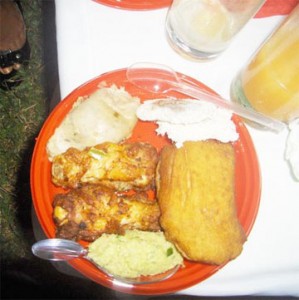
The street art is expressive and full of character, which is perhaps why on some buildings, were individuals were contracted to paint them on legally. Some of the street work tells stories of young men under pressure fighting to get out of their ‘holes’ or struggles while others capture young children either happy or sad. Some of the more impressive street art is on public buildings.
There are those who denounce the art as defacing property, but even they admit that some of it is good. Like a man I met in Gosier, a French town in Guadeloupe. He seemed very upset that “our young people are turning the place into this, this foolishness”, but readily admits that some of them are talented.
In the capital Basse-Terre things seemed more alive than any other place on the island as more people are visible on the streets, which are so animated and alive with colour. The Creole that is spoken with some degree of awkwardness by those I met because “it is not the way we normally speak” according to one woman, actually sounds better when listening to the locals in conversation. There are many on the island who strongly advocate for its preservation pointing to it being a reflection of Guadeloupe’s history as it relates to the days of slavery.
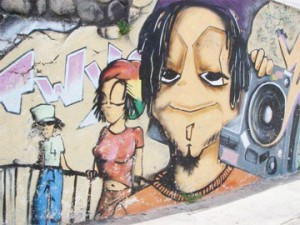
But I hardly managed the time to interact and take in the capital because we drove in and back out mainly for an official function, and that alone. Those on the bus who had visited before were keen to point out where the best spots were and where the Caribbean Sea water would feel warmest. Incredibly, it was just about everywhere in Basse-Terre.
First impressions
and Francis Cabrel
I flew in on Air Antilles, a small carrier operating in the French chain of islands in the Caribbean, which is plagued by frequent industrial action. As it turned out, the day I arrived, some kind of storm was brewing at the airline. The flight to Guadeloupe was scheduled for 2 pm, following my arrival in St Martin just after 11 am, but Air Antilles had pushed back the flight without informing travellers connecting from Caribbean Airlines that day.
As the calls were being made for passengers to board the airport it sounded like French to me, and it was. At no time did Air Antilles announce in English that it was ready for persons to board the aircraft but Air Caraibes did, and I ended up in the wrong line and about to get on the wrong plane, though that flight too was going to Guadeloupe.
Guadeloupe’s Pointe-a-Pitre airport is impressive and modern though on nights when there is little activity it can have a chilling effect. The quiet beauty that defines the island can be deafening to visitors, who turn up ill equipped to communicate in the native French tongue as I was.
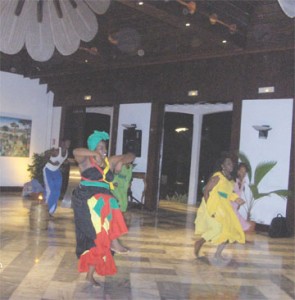
Some time after 7.30 pm, I was stranded at the airport thanks to Air Antilles. As the words “parlez-vous anglais?” (Do you speak English?) rolled off my lips drawing countless clear “Nos” the minutes seemed more unbearable; my decision to favour Spanish over French as a foreign language at school started to haunt me.
“Would you like a taxi?” a calm voice asked and suddenly my worries faded. At last, someone who speaks English though his was with a heavy Jamaican accent. As we drove to the Creole Beach Hotel in Gosier, I learnt that, he was a Jamaican living in Guadeloupe for some six years and working as a taxi operator of most of those years. He likes the island but hates the heavy taxes, and he even had some advice — spend wisely and only if necessary.
Creole Beach Hotel is a fabulous getaway in Gosier with 150-plus rooms, a private beach, double swimming pools, computer stations with internet access, a famed spa and courteous staff if you know how to converse with them. Of the six I encountered, two had a fairly good command of the English language, another two barely spoke it, and the remaining two did not have a clue.
But Creole Beach is deserving of its four stars offering spectacular views of the island and with rooms complete with private patio, kitchen, flat screen television and all programmes in High Definition though regrettably everything aired was in French even National Geographic Explorer and Sponge Bob Square pants.
Guadeloupe has its own Hits and Jams TV that feeds you music videos all day, featuring mostly French and German artistes with smattering of Americans in between. Ayo, a German born singer with African roots, is a hit on the island particularly her song, “Down on my knees”.
But it was the music of French singer, Frances Cabrel that had an impact on me. He sings in French but his emotions can be felt, transcending the language barrier and connecting with anyone listening. His song, “African Tour” from the album, ‘Des Roses Et Des Orties’ is stirring; in it he sings about the indifference shown to African immigrants in Europe and strongly condemns it. Cabrel calls for acceptance and tolerance in Europe in the song.
There was rarely anyone I met living on the island who did not know Cabrel. A young man was so enthused that someone from outside who lacks an understanding of the language would be interested in the music that he went through a catalogue of Cabrel’s songs with me singing as best he could and bearably so. He insisted that I get Cabrel’s CD but after an exhaustive search around the island albeit at 10.30 pm we struck out, failing to find a single music store open.
Boudin de poisson
and the French
Louis Armstrong
There is an abundance of food in Guadeloupe and a sense that food is generally inexpensive costing around 15 euros for breakfast at the hotels. For the locals, produce is affordable and though rice is not a staple, Guadeloupians may not survive if basmati rice, imported from French Guiana, somehow disappears from the island.
While I was there is was impossible to find white rice, if it was not coloured brown it was black and at one time a strange colour, but it tasted good. Pork and seafood are big on the island and can be found in various dishes. There is saying on the island, “If you are not sure just ask”, that is for those who do not eat pork.
Boudin de poisson is a favourite among the locals — they also love fish — and it is usually served at cocktails and parties though you can ask for it at one of the more upscale restaurants. It is like a fish pie but rolled into a neat little ball and seasoned with spices and fresh green seasonings.
“It will make you stronger,” an elderly man advised as I took a bite and without wanting to disappoint I went ahead and swallowed; too much seasonings! But by the time I was ready to leave boudin de poisson had grown on me and I ate about three of them on my last night there.
Coconuts, cassava and bananas are usually included in any food spread on the island. There is one dish called, ‘Kasave’ looks like tiny cassava bread, but it has a meat filling — very delicious. There is a craze on the island for chocolates and sweets particularly diary products yet there are no signs of an obesity problem. While at a farewell dinner at the home of Guadeloupe’s Regional President Victorin Lurel I met Sambia Jil, a Paris-born singer, now residing in Guadeloupe as its resident Louis Armstrong. He looks nothing like the famed US jazz singer but he can fool you with his voice, which is gravelly and very close to Armstrong’s.
Sambia, who speaks English well, tells me that he makes no claim to being as good as, or anywhere near the genius of Armstrong, but he enjoys tricking first-time visitors to the islands into believing that an old record of Armstrong is on when in fact, he is actually singing. He has dreams to go places with his music even mentioning how much admires Francis Cabrel. There was no escaping Cabrel in Guadeloupe.

